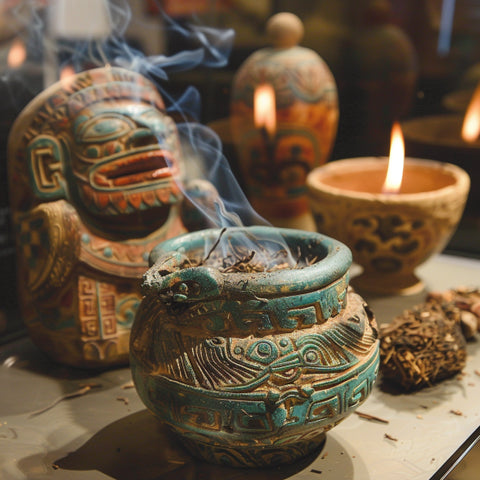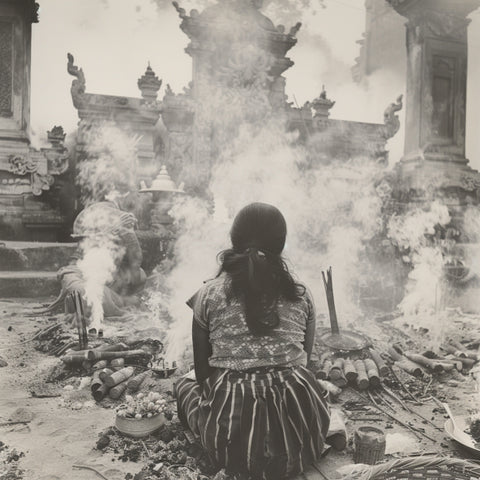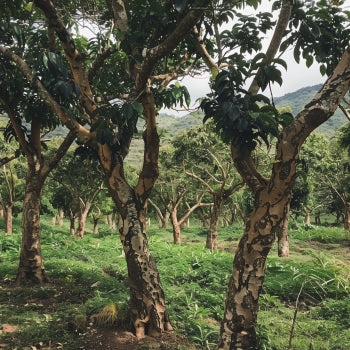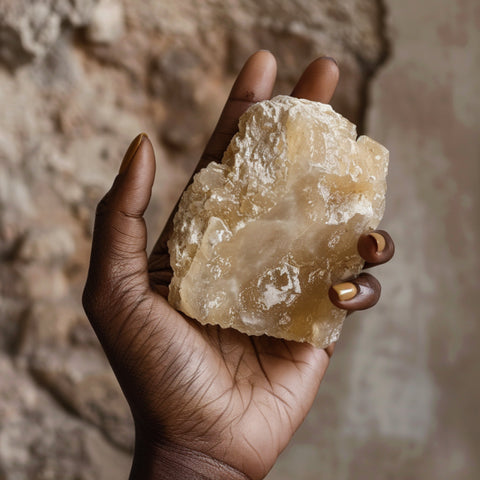Imagine walking through a dense, lush forest, the air thick with the scent of ancient trees and the ground soft underfoot. Suddenly, you come across a tree, its bark scored with deep cuts, from which a golden resin seeps like tears of the sun. This is copal, a sacred gift from the heart of nature, carrying within it the whispers of centuries and the breath of the earth itself.
In this beginner's guide, we invite you on a mystical journey into the soul of copal, a resin revered for its spiritual, artistic, and ecological significance. As we traverse through time and across cultures, we'll unveil the ways in which copal has served as a bridge between the material and the ethereal, offering healing, protection, and a path to mindfulness.
Let the story of copal guide you through enchanted forests of the mind, where art and tradition dance in the light of sustainability. Discover how this ancient resin enriches our lives, connecting us to the rhythms of the earth and the cycles of the stars. Welcome to a world where every grain of copal resin is a starburst of spiritual energy, ready to illuminate the path to inner peace and ecological harmony.

The Historical Significance of Copal
Connecting Past and Present Through Sacred Resin
Long before the modern world began to understand the concept of mindfulness and spiritual healing, ancient civilizations in Mesoamerica had already discovered a powerful ally in their quest to connect with the divine: copal. This sacred resin, harvested from the protective embrace of the Bursera tree, was more than just a substance; it was a bridge to the ethereal, a key to the celestial realms.
In the heart of ancient temples, amidst the shadows cast by towering pyramids and the echoes of age-old chants, copal played a central role. Incense burners, their forms crafted with the utmost reverence and care, would glow with the embers of burning copal, sending spirals of fragrant smoke towards the heavens. This was not merely for ambiance. For the Maya, the Aztecs, and other indigenous peoples, the act of burning copal was a sacred offering, a gesture of respect and devotion to the gods who watched from above.
The smoke of copal, thick and white, was believed to carry the prayers and pleas of the faithful, ascending into the sky to commune with the divine. It served as a purifier, cleansing the soul and the surroundings of negative energies, creating a sacred space where humans and gods could meet. The significance of these rituals cannot be overstated; they were integral to the spiritual fabric of these cultures, woven into their daily lives, their celebrations, and their rites of passage.
Understanding the historical use of copal illuminates its enduring legacy in contemporary spiritual practices. It is a testament to the power of tradition and the deep human need to connect with something greater than ourselves. Today, as we seek to bridge the gap between the past and the present, the burning of copal serves as a reminder of our shared history and our ongoing quest for spiritual awakening and purification.
Through the lens of history, we see copal not just as a resin, but as a sacred vessel for the hopes, dreams, and prayers of countless generations. Its smoke, rising to the heavens, connects us to the ancients, reminding us that we are part of a continuum, forever reaching for the divine, guided by the light of sacred flames and the wisdom of the earth.

Copal in Artistic Expression
Crafting Beauty and Meaning with Nature's Palette
Throughout the annals of history, the boundary between the artistic and the divine has often been blurred, with materials from the natural world serving not just as mediums, but as muses. Copal resin, with its rich aroma and versatile properties, stands as a testament to this timeless synergy between nature and creativity. In the realm of artistic expression, copal has been more than a material; it has been a collaborator, imbuing works of art with depth, durability, and a connection to the spiritual world.
In the hands of skilled artisans, copal resin transforms into a critical ingredient in the creation of varnishes. These varnishes do more than protect; they enhance. Applied to woodwork, they seep into each grain, enriching the natural patterns with a warmth that seems to glow from within. On the canvas, they give paintings a finish that is not only visually stunning but also enduring, safeguarding the artist's vision against the ravages of time and environment. This practice links modern artistry with ancient traditions, echoing the reverence for copal found in historical artifacts and temple adornments.
Beyond its practical applications, copal inspires artists to explore the metaphysical. Jewelry crafted from copal resin—be it in the form of beads, pendants, or intricate carvings—serves as a tangible connection to the natural world, a reminder of the earth's deep mysteries and the role of humans as both creators and protectors. These pieces are not mere adornments but talismans, imbued with intentions of healing, protection, and spiritual awakening.
Sculptures, too, bear witness to the transformative power of copal. In this medium, the resin's natural translucence and warmth are shaped into forms that seem to capture light and shadow, blending the boundaries between the tangible and the ethereal. Each piece tells a story, a narrative of human experience, nature's resilience, and the unseen forces that guide and shape our existence.
The use of copal in artistic expression is a celebration of nature's palette, a tribute to the creativity and ingenuity of human hands and minds. It reflects a deep understanding of the interconnectedness of all things, where art becomes a medium for exploring the complexities of life, the beauty of the natural world, and our place within it. Through copal, artists not only craft beauty and meaning but also forge a timeless link between the material and the spiritual, between the ancient and the modern, between the earth and the ethereal.

Cultural Celebrations and Rituals
The Role of Copal Incense in Uniting Communities
In the tapestry of cultural traditions that span the globe, copal incense weaves a thread of unity, connecting the physical realm with the spiritual in a dance of smoke and scent. It's not merely an aromatic backdrop; it's a vital participant in rituals that bind communities, commemorate the cyclical nature of life, and honor the continuum between the living and the departed. One of the most poignant examples of copal's role in cultural practices is observed during the Day of the Dead celebrations.
During the Day of the Dead, or Día de los Muertos, a celebration deeply rooted in the indigenous traditions of Mexico and recognized worldwide, copal incense plays a crucial role. As families gather to remember and honor their ancestors, the air is filled with the rich, cleansing smoke of burning copal. This sacred resin, believed to possess purifying properties, serves as a beacon for the spirits, guiding them back to the world of the living for a night of reunion and remembrance. The smoke rises in delicate swirls, carrying with it the prayers, wishes, and memories of those gathered, creating a bridge between the earthly and the ethereal.
This ritual underscores the profound significance of copal beyond its aromatic appeal. It becomes a symbol of purification, a tool for spiritual communication, and a means to foster a sense of continuity and connection among the living. The communal act of lighting copal, of sharing in its fragrance and the ambiance it creates, helps to reinforce social bonds and cultural identity. It's a moment when time stands still, and the barriers between past and present blur, allowing for a space where community, tradition, and ancestral homage converge.
Furthermore, copal's use in rituals extends beyond the Day of the Dead. Various cultures and spiritual practices incorporate copal incense in ceremonies designed to cleanse spaces, objects, and individuals of negative energy, to facilitate healing, and to invite positive influences. Its role in these rituals is not only about the physical act of burning incense but also about the collective participation in practices that underscore shared beliefs and values.
The incorporation of copal in cultural celebrations and rituals exemplifies how sensory experiences—smell, in this case—can evoke memory, foster community, and bridge the temporal divide. The act of burning copal incense becomes a ritual in itself, a shared experience that transcends the individual, linking generations and reinforcing the fabric of community through the simple, yet profound act of remembering and honoring.
In this way, copal incense does not merely scent the air; it weaves a narrative of unity, memory, and spiritual continuity, playing an indispensable role in the mosaic of human cultural expression. It reminds us of the power of tradition to bind us to our ancestors, to each other, and to the spiritual world, reinforcing the enduring human capacity for reverence, celebration, and communal solidarity.

Sustainability and the Copal Tree
Protecting the Environment One Resin at a Time
Everyday Uses of Copal
Bringing Ancient Wisdom into Modern Living
The enchanting aroma of copal resin, once revered in ancient temples, finds its place in the contemporary world, blending the mystique of the past with the practicality of the present. Copal, with its rich history and spiritual significance, extends beyond the realms of artistic expression and spiritual rituals into everyday life, offering benefits that cater to modern needs while fostering a deep connection with nature. In this section, we explore the myriad ways in which copal can be seamlessly integrated into daily routines, enhancing well-being and drawing us closer to the natural world.
A Natural Insect Repellent
One of the most practical uses of copal is its efficacy as a natural insect repellent. Unlike synthetic repellents that may contain harmful chemicals, copal offers a safe and eco-friendly alternative. When burned, copal incense releases a smoke that is not only pleasing to the senses but also repels mosquitoes and other insects. This makes it an ideal companion for evenings spent outdoors, whether you're enjoying a quiet moment in your backyard or embarking on a camping adventure in the wilderness.
Aromatherapy and Mental Clarity
The benefits of copal extend into the realm of aromatherapy, where its soothing aroma can have a profound effect on mental well-being. Burning copal resin or using copal essential oil in a diffuser can help to purify the air, reduce stress, and enhance concentration. Its calming properties are particularly beneficial for creating a serene environment conducive to meditation, yoga, or any practice focused on mindfulness and mental clarity. Incorporating copal into your daily routines can serve as a reminder to pause, breathe, and reconnect with oneself amidst the hustle and bustle of modern life.
Natural Air Freshener and Purifier
Copal's pleasant fragrance also makes it an excellent natural air freshener, capable of neutralizing odors without the use of artificial scents. Its purifying smoke goes beyond mere odor elimination, clearing the air of negative energy and inviting positive vibes into your space. This makes it perfect for use in homes and offices, creating a welcoming atmosphere that uplifts the spirit and fosters a sense of peace.
Skincare Benefits
The resinous sap of the copal tree, rich in therapeutic properties, has also found its way into the world of natural skincare. Copal oil, derived from the resin, can be used to soothe skin irritations, promote healing of minor cuts and burns, and improve overall skin health. Its antibacterial properties make it a valuable ingredient in natural cosmetics and skincare formulations, offering a gentle yet effective solution for maintaining healthy, radiant skin.
Enhancing Creativity and Focus
For those seeking to boost their creativity and focus, copal can be a powerful ally. The resin's uplifting aroma stimulates the senses, clears the mind, and fosters an environment conducive to creative thinking and concentration. Artists, writers, and anyone involved in creative pursuits may find that burning copal incense during their work sessions helps to unlock new ideas and maintain a steady flow of inspiration.
Spiritual Cleansing and Protection
Incorporating copal into daily spiritual practices can aid in cleansing the aura, protecting against negative energies, and promoting emotional balance. Its use in ritualistic cleansing, known as "smudging," can help to clear a space or individual of negative vibrations, fostering an environment of harmony and protection. This ancient practice, rooted in indigenous traditions, continues to be a vital part of many people's spiritual routines, bridging the gap between ancient wisdom and modern living.
By integrating copal into our daily lives, we not only avail ourselves of its practical benefits but also cultivate a deeper appreciation for the natural world and its timeless gifts. Copal serves as a reminder of the interconnectedness of all things and the importance of living in harmony with nature. Whether used for its aromatic properties, spiritual significance, or practical applications, copal resin remains a versatile and valuable resource, offering a touch of ancient wisdom to modern living.




0 comments